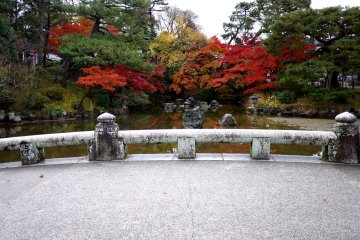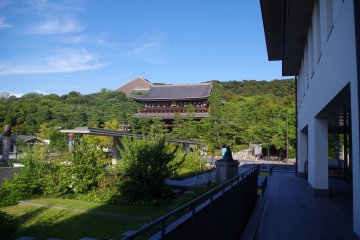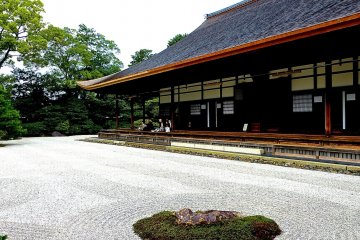
Kyoto Maruyama Park
Tomoko KamishimaKyoto Maruyama Koen Park: Delicate cherry blossoms in spring, and colorful autumn trees are both splendid here.

Maruyama Park is the oldest public park in Kyoto and a popular springtime cherry blossom viewing spot. It opened in 1886 and is located next to Yasaka Shrine in Higashiyama District.
The park was laid out by the well-known gardening expert Ogawa Jibee (1860–1933). As it is one of the most popular places for hanami in Kyoto, it can get quite crowded during the high season in April. The main attraction of the park is a beautiful weeping cherry that is illuminated at night.
In the southwest of the park is the Chorakukan Villa, which the Japanese tobacco king Murai Kichibee had built. This property is now used as a hotel.
This gorgeous weeping cherry tree is the star of the park. The blossoms in spring offer a beautiful scene to everyone in the park. It is also known as the Gion weeping cherry tree.
15-minute walk from Kawaramachi Station on the Hankyu Line or 10-minute walk from Gion Shijo Station on the Tozai Line.

Kyoto Maruyama Koen Park: Delicate cherry blossoms in spring, and colorful autumn trees are both splendid here.

Photos of spring hanami party at Maruyama park in Kyoto, with people celebrating under lit-up cherry blossom trees.

Red maple leaves around the pond in Maruyama Park make it an attractive place to enjoy autumn color in Kyoto.

Chionin Wajun-kaikun is in a peaceful area of Kyoto where you can find rest and relaxation for your body and mind.

Enjoy a luxury getaway at Hotel SOWAKA, tucked away in Kyoto's Gion district just moments away from Yasaka Shrine.

Comfortable hotel with spa bath in a room and free breakfast, in the center of Kyoto.

Trattoria Minoura is a small restaurant near Kodai-ji Temple and Yasaka Jinja Shrine. Their weekday lunch set (1500 yen) is quite reasonable and tasted pretty good. It includes a main pasta dish with a small salad and bread. Drinks and desert are extra.

The Iyemon Cafe blends the peaceful aura of wabi sabi with modern minimalist chic in Kyoto's Karasuma Sanjo and Oike business district

In Japan's former capital of Kyoto, Mimikou udon is a small, inexpensive noodle shop, with a good range of tasty, filling dishes.

The Yasaka Cry, located in the Gion district in Kyoto, is often referred to as the Gion Shrine. The shrine is one of the most famous shrines in the city of Kyoto and is located at the end of Shijo-dori Street. The grounds of the shrine include several buildings and gates. Including the main hall and also a stage. Every year, Yakasa Shrine hosts numerous events and festivals that are important to the Japanese and is a popular destination for many visitors to Kyoto City. The Yasaka Shrine respects the gods Susanoo-no-mikoto, Kushiinadahime-no-mikoto, and Yahashira-no-mikogami. Above all, Susanoo-no-mikoto is an important god in Japanese mythology, known for his victory over Yamata-no-orochi (a great serpent with eight heads: a symbol of numerous disasters).

Kodaiji (高台寺) is located northeast of the Yasaka Hokanji Temple at the foot of the Higashiyama Ryozen Mountains in Kyoto. The official name of the temple is Kodaiji-Jushozenji Temple. In 1606, the temple of Kita-no-Mandokoro was dedicated in memory of her late husband. Kita-no-Mandokoro was also known as nene. The Kaisando (Founder's Hall), Otama-ya (Sanctuary), Kasatei (Tea House), Shiguretei (Tea House), Omotetmon (Gate to the Sanctuary), and Kangetsudai (Moon Viewing Pavilion) are designated as important cultural assets in Japan. The temple garden is said to have been designed by the landscape gardener Kobori Enshu (1579-1647). The Japanese government has designated the garden as a historic site and a place of scenic beauty. The interior of the main building was originally painted with lacquer and covered with exquisite gold decorations. However, the current building was rebuilt in 1912 after several fires. Kodai-ji hosts modern art exhibitions in spring and fall. These are set up in the rock garden in front of Houjyo and are creatively illuminated at night.

Kennin-ji is a historic Zen Buddhist temple in Higashiyama, Kyoto, Japan, near Gion, at the end of Hanami Lane. It is considered to be one of the so-called Kyoto Gozan or "five most important Zen temples of Kyoto". [Wikipedia]